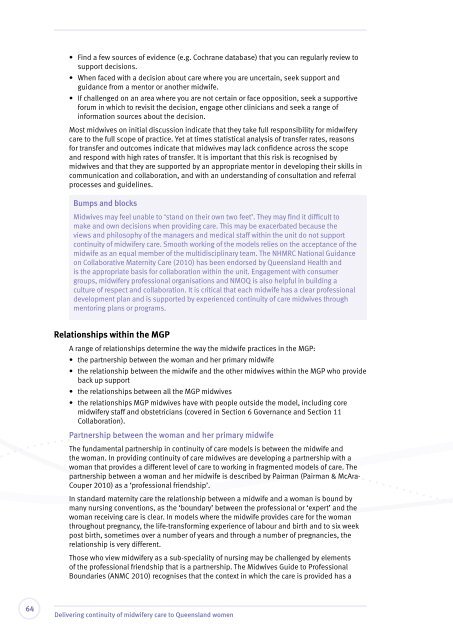Delivering continuity of midwifery care to Queensland women
Delivering continuity of midwifery care to Queensland women
Delivering continuity of midwifery care to Queensland women
Create successful ePaper yourself
Turn your PDF publications into a flip-book with our unique Google optimized e-Paper software.
• Find a few sources <strong>of</strong> evidence (e.g. Cochrane database) that you can regularly review <strong>to</strong><br />
support decisions.<br />
• When faced with a decision about <strong>care</strong> where you are uncertain, seek support and<br />
guidance from a men<strong>to</strong>r or another midwife.<br />
• If challenged on an area where you are not certain or face opposition, seek a supportive<br />
forum in which <strong>to</strong> revisit the decision, engage other clinicians and seek a range <strong>of</strong><br />
information sources about the decision.<br />
Most midwives on initial discussion indicate that they take full responsibility for <strong>midwifery</strong><br />
<strong>care</strong> <strong>to</strong> the full scope <strong>of</strong> practice. Yet at times statistical analysis <strong>of</strong> transfer rates, reasons<br />
for transfer and outcomes indicate that midwives may lack confidence across the scope<br />
and respond with high rates <strong>of</strong> transfer. It is important that this risk is recognised by<br />
midwives and that they are supported by an appropriate men<strong>to</strong>r in developing their skills in<br />
communication and collaboration, and with an understanding <strong>of</strong> consultation and referral<br />
processes and guidelines.<br />
Bumps and blocks<br />
Midwives may feel unable <strong>to</strong> ‘stand on their own two feet’. They may find it difficult <strong>to</strong><br />
make and own decisions when providing <strong>care</strong>. This may be exacerbated because the<br />
views and philosophy <strong>of</strong> the managers and medical staff within the unit do not support<br />
<strong>continuity</strong> <strong>of</strong> <strong>midwifery</strong> <strong>care</strong>. Smooth working <strong>of</strong> the models relies on the acceptance <strong>of</strong> the<br />
midwife as an equal member <strong>of</strong> the multidisciplinary team. The NHMRC National Guidance<br />
on Collaborative Maternity Care (2010) has been endorsed by <strong>Queensland</strong> Health and<br />
is the appropriate basis for collaboration within the unit. Engagement with consumer<br />
groups, <strong>midwifery</strong> pr<strong>of</strong>essional organisations and NMOQ is also helpful in building a<br />
culture <strong>of</strong> respect and collaboration. It is critical that each midwife has a clear pr<strong>of</strong>essional<br />
development plan and is supported by experienced <strong>continuity</strong> <strong>of</strong> <strong>care</strong> midwives through<br />
men<strong>to</strong>ring plans or programs.<br />
Relationships within the MGP<br />
A range <strong>of</strong> relationships determine the way the midwife practices in the MGP:<br />
• the partnership between the woman and her primary midwife<br />
• the relationship between the midwife and the other midwives within the MGP who provide<br />
back up support<br />
• the relationships between all the MGP midwives<br />
• the relationships MGP midwives have with people outside the model, including core<br />
<strong>midwifery</strong> staff and obstetricians (covered in Section 6 Governance and Section 11<br />
Collaboration).<br />
Partnership between the woman and her primary midwife<br />
The fundamental partnership in <strong>continuity</strong> <strong>of</strong> <strong>care</strong> models is between the midwife and<br />
the woman. In providing <strong>continuity</strong> <strong>of</strong> <strong>care</strong> midwives are developing a partnership with a<br />
woman that provides a different level <strong>of</strong> <strong>care</strong> <strong>to</strong> working in fragmented models <strong>of</strong> <strong>care</strong>. The<br />
partnership between a woman and her midwife is described by Pairman (Pairman & McAra-<br />
Couper 2010) as a ‘pr<strong>of</strong>essional friendship’.<br />
In standard maternity <strong>care</strong> the relationship between a midwife and a woman is bound by<br />
many nursing conventions, as the ‘boundary’ between the pr<strong>of</strong>essional or ‘expert’ and the<br />
woman receiving <strong>care</strong> is clear. In models where the midwife provides <strong>care</strong> for the woman<br />
throughout pregnancy, the life-transforming experience <strong>of</strong> labour and birth and <strong>to</strong> six week<br />
post birth, sometimes over a number <strong>of</strong> years and through a number <strong>of</strong> pregnancies, the<br />
relationship is very different.<br />
Those who view <strong>midwifery</strong> as a sub-speciality <strong>of</strong> nursing may be challenged by elements<br />
<strong>of</strong> the pr<strong>of</strong>essional friendship that is a partnership. The Midwives Guide <strong>to</strong> Pr<strong>of</strong>essional<br />
Boundaries (ANMC 2010) recognises that the context in which the <strong>care</strong> is provided has a<br />
64<br />
<strong>Delivering</strong> <strong>continuity</strong> <strong>of</strong> <strong>midwifery</strong> <strong>care</strong> <strong>to</strong> <strong>Queensland</strong> <strong>women</strong>
















